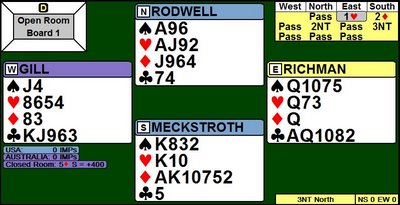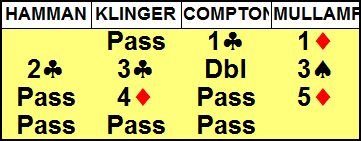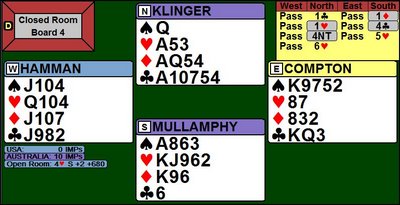Treasure Mine - Systems & Style - Chapter 1 - Australia USA - Part 1 of 3
The recent world championship gives us a treasure trove that can be examined to study systems and style implications for success.
Chapter 1 will be my favorite round robin match, Australia vs USA, in round 13. We will look at 6 boards that will cover all the IMPs scored except for 3 IMPs by each side. There are five major swings, and a board with a lot of action.
The match opened with a 10 IMP swing to Australia:

.
.
.
.
.
.
.
We've discussed the Richman-Nagy system previously and Richman-Gill were using much the same thing - 1C is 15+, and here 1H is 9-14 with 4+Ss, can have a longer minor. Meckstroth overcalled 2D, Rodwell bid 2NT, raised to 3NT, and this was down since neither had a club stopper. Note that Rodwell passes initially, as they don't open 10s balanced. Meckwell needed more science here - for example a way for South to show a singleton club - but it is rare this will come up. If Rodwell had cuebid, the auction could have started (1H-)2D;-2S-2NT;-3D-3H. South can bid 2NT as forcing, as the cuebid promises a diamond fit, so the auction should continue to at least 3D. When South rebids 3H, North knows to move to a suit contract.
Here's the closed room auction:

.
.
.
.
.
Compton opened a standard 1C, and after the 1D overcall, Hamman bid 2C where others might have jumped to 3C, weak (if available) or bid 1H (since they play 1C-1D as a transfer to Hs, it would work to play 1C-(1D)-Double as a transfer to Hs). Over 2C now Klinger could cuebid 3C and they reached the great 5D game - it's so good that 6D can be made on this layout, by declarer starting hearts with a heart to the ten to establish 4 heart tricks. Note a 3C preempt over 1D would leave North with a selection of unclear options - 3D, 4D, Double, 4C, each with their imperfections - it pays to consume bidding space, at least when partner is not strong either.
On board 4 (see below), Mullamphy, South, transferred to hearts, and 1H by Klinger showed 3 hearts. Now 4C showed short clubs, slam interest, and slam was quickly reached. Compton found the good trump lead, but the heart queen offside was countered by 3-3 diamonds, and the slam came in.

.
.
.
.
.
.
.
In the open room, Rodwell started with a big 16+ club, East overcalled (likely 1S though vugraph shows 1NT, even though that is for the minors), Meckstroth bid 2H, Rodwell bid 3D as an artificial heart raise, Meckstroth rebid 3S to deny 2 of the top 3 hearts, and Rodwell settled for 4H. There they played, losing 13 IMPs. 1S doubled, if that could be the final contract, would be -800 or, if declarer misguesses spades (will be leading out of hand - has to lead king to bed queen) -1100. If East had been more distributional for his vulnerable overcall, it likely would have been right for Meckwell to stay out of slam. As it was the flat overcall worked this time on this layout, but I think it is a long term losing bid when vulnerable.
The recent world championship gives us a treasure trove that can be examined to study systems and style implications for success.
Chapter 1 will be my favorite round robin match, Australia vs USA, in round 13. We will look at 6 boards that will cover all the IMPs scored except for 3 IMPs by each side. There are five major swings, and a board with a lot of action.
The match opened with a 10 IMP swing to Australia:
.
.
.
.
.
.
.
We've discussed the Richman-Nagy system previously and Richman-Gill were using much the same thing - 1C is 15+, and here 1H is 9-14 with 4+Ss, can have a longer minor. Meckstroth overcalled 2D, Rodwell bid 2NT, raised to 3NT, and this was down since neither had a club stopper. Note that Rodwell passes initially, as they don't open 10s balanced. Meckwell needed more science here - for example a way for South to show a singleton club - but it is rare this will come up. If Rodwell had cuebid, the auction could have started (1H-)2D;-2S-2NT;-3D-3H. South can bid 2NT as forcing, as the cuebid promises a diamond fit, so the auction should continue to at least 3D. When South rebids 3H, North knows to move to a suit contract.
Here's the closed room auction:
.
.
.
.
.
Compton opened a standard 1C, and after the 1D overcall, Hamman bid 2C where others might have jumped to 3C, weak (if available) or bid 1H (since they play 1C-1D as a transfer to Hs, it would work to play 1C-(1D)-Double as a transfer to Hs). Over 2C now Klinger could cuebid 3C and they reached the great 5D game - it's so good that 6D can be made on this layout, by declarer starting hearts with a heart to the ten to establish 4 heart tricks. Note a 3C preempt over 1D would leave North with a selection of unclear options - 3D, 4D, Double, 4C, each with their imperfections - it pays to consume bidding space, at least when partner is not strong either.
On board 4 (see below), Mullamphy, South, transferred to hearts, and 1H by Klinger showed 3 hearts. Now 4C showed short clubs, slam interest, and slam was quickly reached. Compton found the good trump lead, but the heart queen offside was countered by 3-3 diamonds, and the slam came in.
.
.
.
.
.
.
.
In the open room, Rodwell started with a big 16+ club, East overcalled (likely 1S though vugraph shows 1NT, even though that is for the minors), Meckstroth bid 2H, Rodwell bid 3D as an artificial heart raise, Meckstroth rebid 3S to deny 2 of the top 3 hearts, and Rodwell settled for 4H. There they played, losing 13 IMPs. 1S doubled, if that could be the final contract, would be -800 or, if declarer misguesses spades (will be leading out of hand - has to lead king to bed queen) -1100. If East had been more distributional for his vulnerable overcall, it likely would have been right for Meckwell to stay out of slam. As it was the flat overcall worked this time on this layout, but I think it is a long term losing bid when vulnerable.

0 Comments:
Post a Comment
<< Home